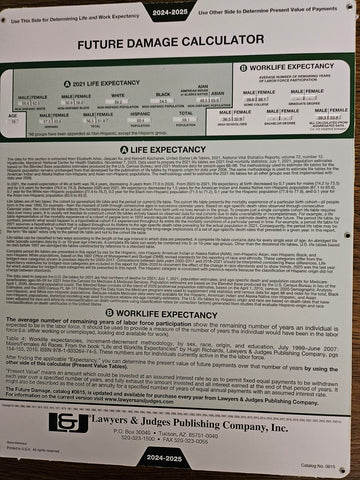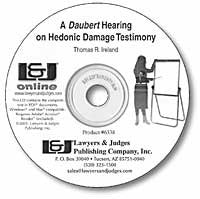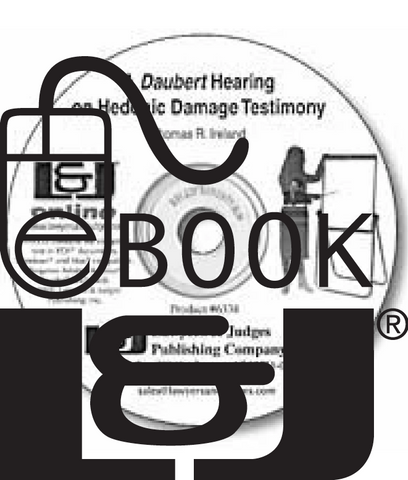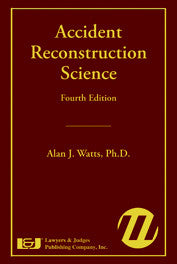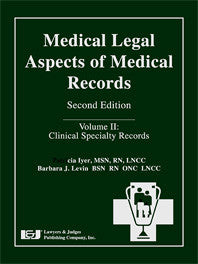
Medical Legal Aspects of Medical Records, Second Edition (Volume II)
- Author: Patricia W. Iyer, Barbara J. Levin
- ISBN 10: 1-933264-80-2
- ISBN 13: 978-1-933264-80-6
- Copyright Date Ed: February 1, 2010
- Pages: 672 pages
- Binding Information: Casebound
- Size: 8.5 ✕ 11 Inches (US)
Medical Legal Aspects of Medical Records, Second Edition is the reference of choice for cases involving medical records and their use. The book has been divided into two volumes for ease of finding the information you need. Both volumes have been updated to give you the latest information, as recent changes in legislation and technology have changed the medical records process. The authors have designed this work to give extensive information on the HIPPA policies, standards initiatives, legal use of records, billing and coding, and computerization of records and record keeping systems and how they apply in forensic situations.
Use Volume I to get a comprehensive overview of the medical records process. In any health care situation, records are made, and each situation presents its own unique aspects and challenges. This book explores the many aspects of medical records that apply across all specialties. It is specially designed to complement Volume II.
Use Volume II for in-depth information on many clinical specialties. This book informs you of the specific nature of clinical specialty records and hospital areas of specialty are covered, including chapters on dental, chiropractic, nursing home, pediatrics, medication, and home care. It is specially designed to complement Volume I.
Used jointly, these two Volumes are a powerful tool for your practice and are exceptionally valuable to all those in the legal profession or in law enforcement who deal with medical records on a regular basis.
This book is also available as an eBook. Click here to purchase and download:
Topics Include:
- Complementary and alternative medicine
- Dental records
- Home care records
- Independent medical examination
- Office-based medical records
- Ophthalmology records
- Emergency medical services records
- Emergency department records
- Critical care records
- Diagnostic testing
- Intravenous therapy records
- Long-term care records
- Medical surgical records
- Medication records
- The nursing process and nursing records
- Obstetrical records
- Orthopedic records
- Pain assessment and management
- Pediatric records
- Perioperative records
- Physician documentation
- Psychiatric records
- Physical therapy records
- Rehabilitation records
- Respiratory care records
- Skin trauma
- Medical terminology and abbreviations
- Internet resources
- Textbook references
- Glossary
- And more!
Use Volume II for in-depth information on many clinical specialties. This book informs you of the specific nature of clinical specialty records and hospital areas of specialty are covered, including chapters on dental, chiropractic, nursing home, pediatrics, medication, and home care.
It is specially designed to complement Volume I. Used jointly, these two Volumes are a powerful tool for your practice and are exceptionally valuable to all those in the legal profession or in law enforcement who deal with medical records on a regular basis.
Table of Contents:
Chapter 1: Complementary and Alternative Medicine—Chiropractic, Acupuncture, and Massage
Douglas R. Briggs, DC, Dipl.Ac.(IAMA), DAAPM, John A. Amaro, DC, Dipl.Ac.(IAMA), Dipl.Ac.(NCCAOM), Kimberly Combs, LMT, and Stacy S. Cohen, DC
1.1 Chiropractic
1.2 Acupuncture
1.3 Massage
1.4 Integrative Medicine
Chapter 2: Dental Records
Barry C. Cooper, DDS
2.1 Introduction
2.2 Background of Dentistry—Terminology
2.3 Extent of Dental Records
2.4 Disorders of Dental/Oral and Adjacent Structures
2.5 Dental Procedures/Treatments
2.6 Complications of Treatment
2.7 Documentation Practices
2.8 Use of a Dental Expert Witness
2.9 Summary
Chapter 3: Home Care Records
Barbara Mladenetz Weber Berry, MSN, RN
3.1 What Is Home Care?
3.2 Documentation in Home Care
3.3 Risks in Home Care
3.4 At-Risk and Non-Compliant Client
3.5 Home Care Cases
3.6 Recommendations for Reviewing the Home Care Record
3.7 Summary
Chapter 4: Independent Medical Examination
Marjorie Eskay-Auerbach, MD, JD
4.1 Introduction
4.2 The Examiner’s Role
4.3 Choice of an IME Physician
4.4 Differing Legal Perspectives on IMEs and Caveats
4.5 Scheduling an IME or Record Review
4.6 Structure of the Independent Medical Examination and Report
4.7 Review of Medical Records
4.8 Medical/Legal Controversies
4.9 Impressions and Professional Opinions
4.10 Evidence-Based Medicine
4.11 Role of the AMA Guides
4.12 Summary
Chapter 5: Office-Based Medical Records
Keith M. Starke, MD, FACP and Ginny Tucci Starke, MSN, RN
5.1 Introduction
5.2 Paper-Based Systems
5.3 Sections of Information Found in the Office Records Related to the Patient
5.4 Electronic Medical Records
5.5 Governing Organizations’ Documentation Guidelines
5.6 Physician Notes
5.7 Referrals or Consultations
5.8 How to Evaluate Office Medical Records
5.9 Is the Physician the Only Examiner?
5.10 Is There Office Nurse Documentation?
5.11 Does the Office Have a Protocol for Performing and Communicating Test Results?
5.12 How Does the Office Handle Phone Call Documentation?
5.13 Is There Documentation of Referral When Necessary?
5.14 Are There Red Flags Present in the Medical Record?
5.15 Patient Behavior
5.16 Summary
Chapter 6: Ophthalmology Records
Elliott M. Korn, MD
6.1 Introduction
6.2 Providers of Eye Care
6.3 Visual Acuity
6.4 Clinical Examinations
6.5 Eye Symbols and Abbreviations
6.6 Refractive Errors
6.7 Ocular Structures
6.8 Disease States
6.9 Summary
Chapter 7: Emergency Medical Services Records
Mary Fakes, RN, MSN and Scott A. Mullins, AAS, EMT-P
7.1 Introduction
7.2 History and Development of EMS Systems
7.3 Types of Services
7.4 EMS Certifications
7.5 Types of Patient Transports
7.6 Transport and Crew Responsibilities
7.7 Medical Direction
7.8 Documentation
7.9 Refusal of Care
7.10 Do Not Resuscitate
7.11 Controlled Substances
7.12 Communications
7.13 Termination of Resuscitation in the Field
7.14 Summary
Chapter 8: Emergency Department Records
Dana Stearns, MD
8.1 Introduction
8.2 The Triage Process
8.3 Documentation of Triage and Treatment
8.4 Diagnosis (DX)
8.5 Patient Management
8.6 The Trauma Patient
8.7 Documentation of Patient Management
8.8 Summary
Chapter 9: Critical Care Records
Kathleen C. Ashton, APRN, BC, PhD
9.1 Introduction to Critical Care Nursing
9.2 Types of Units
9.3 Standards of Critical Care Nursing
9.4 The Practice of Critical Care Medicine and Nursing
9.5 Documentation Issues
9.6 Types of Records and Systems
9.7 Use of Computerized Records
9.8 The Bedside Flow Sheet
9.9 Physician Documentation
9.10 Comparison of Records by Type of Institution—"Magnet" Status
9.11 Special Circumstances Encountered in Critical Care
9.12 Sources of Liability
9.13 Summary and Recommendations
Chapter 10: Diagnostic Testing
Bruce Bonnell, MD, MPH
10.1 Introduction
10.2 Diagnostic Tests Involving Blood Work
10.3 Microbiology
10.4 Imaging Tests
10.5 Testing in Cardiology
10.6 Summary
Chapter 11: Intravenous Therapy Records
Susan Masoorli, RN
11.1 Introduction
11.2 Peripheral Vascular Access Devices
11.3 Central Venous Access Devices
11.4 Site Monitoring Documentation
11.5 Legal Issues
11.6 Vascular Access Device Complications
11.7 Conclusion
Chapter 12: Long-Term Care Records
Gloria Blackmon, AAS, BSN, RN-BC, LNHA, Patricia Iyer, MSN, RN, LNCC, Angela Tobias, RN, BSN, MSHSA, LNCC, CHCC and Jill Thomas, RNC, CWOCN, LNHA
12.1 Introduction
12.2 Assisted Living
12.3 Long-Term Acute Care Hospitals (LTACHs)
12.4 Long-Term Care Diversity
12.5 Subacute Care
12.6 Overview of Documentation in Long-Term
12.7 The Importance and Purpose of Documentation in Long-Term Care
12.8 Regulations Pertaining to Long-Term Care Medical Records
12.9 Admission and Care Planning Documents
12.10 Nurses’ Notes
12.11 Additional Nursing Documentation
12.12 Ancillary Services Documentation
12.13 Physician Documentation
12.14 Medicare Documentation
12.15 Discharge Documentation
12.16 Careless Documentation
12.17 Summary
Chapter 13: Medical Surgical Records
Sally Russell, MSN, RN
13.1 Introducti
13.2 Respiratory System
13.3 Cardiovascular System
13.4 Neurological System
13.5 Renal System
13.6 Musculoskeletal System
13.7 Integumentary System
13.8 Endocrine System
13.9 Gastrointestinal System
13.10 Summary
Chapter 14: Medication Records
Michael T. Lennon, PharmD, MBA, RPh, JD
14.1 Introduction
14.2 Overview of Pharmacy Practice
14.3 Pharmacists’ Roles and Responsibilities
14.4 Medication Related Records
14.5 Legal Considerations
14.6 Summary
Chapter 15: The Nursing Process and Nursing Records
Patricia Iyer, MSN, RN, LNCC
15.1 Overview of Documentation
15.2 Why Do Nurses Document?
15.3 Trends in Charting
15.4 Initial Database: Admission Assessment
15.5 Priority Assessment Issues
15.6 Components of the Planning Process
15.7 Care Planning
15.8 Documentation of Discharge Planning
15.9 Documentation of Implementation
15.10 Implementation of the Plan
15.11 Documentation of Referrals
15.12 Documentation of Evaluation
15.13 Summary
Chapter 16: Obstetrical Records
Joanne McDermott, MA, RN
16.1 Introduction
16.2 Health History/Initial Pregnancy Profile
16.3 Estimating the Date of Birth
16.4 Prenatal Flow Sheet
16.5 Prenatal Testing
16.6 Intrapartum Care
16.7 Electronic Fetal Monitoring
16.8 Non-Reassuring Fetal Heart Rate Patterns
16.9 Pitocin Induction and Augmentation
16.10 Analgesia and Anesthesia
16.11 Cesarean Sections
16.12 Vaginal Birth after Cesarean (VBAC)
16.13 Labor and Delivery Summary
16.14 Complications in Pregnancy
16.15 Anesthesia Record
16.16 Operative Record
16.17 Post-Anesthesia Care Unit (PACU)
16.18 Computerized Charting
16.19 Commonly Used Obstetrical Abbreviations
16.20 Summary
Chapter 17 : Orthopaedic Records
Barbara J. Levin, BSN, RN, ONC, LNCC and Howard Yeon, MD, JD
17.1 Introduction
17.2 Orthopaedic Definitions and Terminology
17.3 Traumatic Injuries
17.4 Essential Elements of the Musculoskeletal Trauma Patient’s Medical Record
17.5 Elective Orthopaedic Procedures
17.6 Essential Elements of the Elective Orthopaedic Patient’s Medical Record
17.7 Orthopaedic Complications
17.8 Nursing Care Plans
17.9 Summary
Chapter 18 : Pain Assessment and Management
Yvonne D’Arcy, MS, RN, CRNP, CNS
18.1 Introduction
18.2 National Guidelines for Pain Management
18.3 Elements of Pain Assessment
18.4 Pain Instruments
18.5 Documentation
18.6 Commonly Used Pain Medications
18.7 Specialty Pain Assessment and Documentation
18.8 Summary
Chapter 19: Pediatric Records
Susan G. Engleman, MSN, RN, APRN, BC, PNP, CLCP
19.1 Introduction
19.2 Basic Tips for Non-Medical Professionals Reviewing Medical Records
19.3 Why Are Pediatric Patients Different?
19.4 What Should the Child’s Chart Contain?
19.5 Red Flags in the Chart
19.6 Failure to Recognize Compensatory Mechanisms
19.7 How Do I Know if I Need a Pediatric Expert?
19.8 Conclusions: "Proceed with Caution"
Chapter 20 : Perioperative Records
Jo Anne Kuc, BSN, RN, LNCC
20.1 Introduction
20.2 Preoperative Period
20.3 Pre-Surgical Phase
20.4 Intraoperative Nursing Documentation
20.5 Documentation of Anesthesia Care
20.6 Post-Anesthesia Care Unit Documentation
20.7 Outpatient Surgery Discharge
20.8 Summary
Chapter 21: Physician Documentation in Hospitals and Nursing Homes
Jeffrey M. Levine, MD
21.1 Introduction
21.2 Physician Roles and Responsibilities for Documentation
21.3 Forces That Shape Documentation
21.4 Accreditation Requirements
21.5 Summary
Chapter 22 : Psychiatric Records
Wanda K. Mohr, RN, FAAN, PhD
22.1 Introduction
22.2 The Development of the Diagnostic and Statistical Manual of Mental Disorders
22.3 Use and Structure of the Diagnostic and Statistical Manual of Mental Disorders
22.4 Validity, Reliability, and Limitations
22.5 The Diagnostic Process
22.6 The Medical Record—From Diagnosis to Discharge
22.7 The Multidisciplinary Team and Documentation,in the Medical Record
22.8 Psychiatric Terminology and Accuracy in Communication in the Medical Record
22.9 Uses and Misuses of Terminology=
22.10 Documenting Special Circumstances in the Medical Record=
22.11 Summary
Chapter 23 : Physical Therapy Records
Gwen Simons, PT, JD, OCS, FAAOMPT
23.1 Introduction
23.2 What is Physical Therapy?
23.3 The Physical Therapist’s Documentation
23.4 Evidence in the Physical Therapy Record
23.5 The Physical Therapist as an Expert Witness
23.6 Summary
Chapter 24 : Rehabilitation Records
Jane O’Rourke, MSN, RN, CNAA
24.1 Introduction
24.2 The Rehabilitation Team
24.3 Scope of Documentation
24.4 Summary
Chapter 25: Respiratory Care Records
Hilary J. Flanders, MPH, RN-BC, RRT
25.1 Introduction
25.2 Types of Patients Who May Require Respiratory Care
25.3 Professionals Who Provide Respiratory Care in the United States
25.4 Clinical Issues
25.5 Respiratory Equipment and Medications
25.6 Diagnostic Tests
25.7 Respiratory Diseases and Management Techniques
25.8 Summary
Chapter 26 : Skin Trauma
Kelly A. Jaszarowski, MSN, RN, CNS, ANP, CWOCN
26.1 Introduction
26.2 Wounds
26.3 Burns
26.4 Pressure Ulcers
26.5 Incontinence
26.6 Ostomies
26.7 Summary
Chapter 27 : Controversies in Skin Trauma
Steven Charles Castle, MD
27.1 Introduction
27.2 Surgical Wounds
27.3 Psychological Factors Associated with Skin Trauma
27.4 Overview of Wounds
27.5 Pressure Ulcers
27.6 Quality of Nursing Care and Documentation in Long-Term-Care Facilities
27.7 Controversies in the Use of Specialized Care for the Prevention and Treatment of Pressure Ulcers
27.8 Nutritional Support in Wound Healing
27.9 Summary
Appendix A: Medical Terminology, Abbreviations, Acronyms, and Symbols
Ann M. Peterson, EdD, MSN, RN, CS, LNCC
Appendix B: Internet Resources
Appendix C: Textbook References
Appendix D: Glossary

